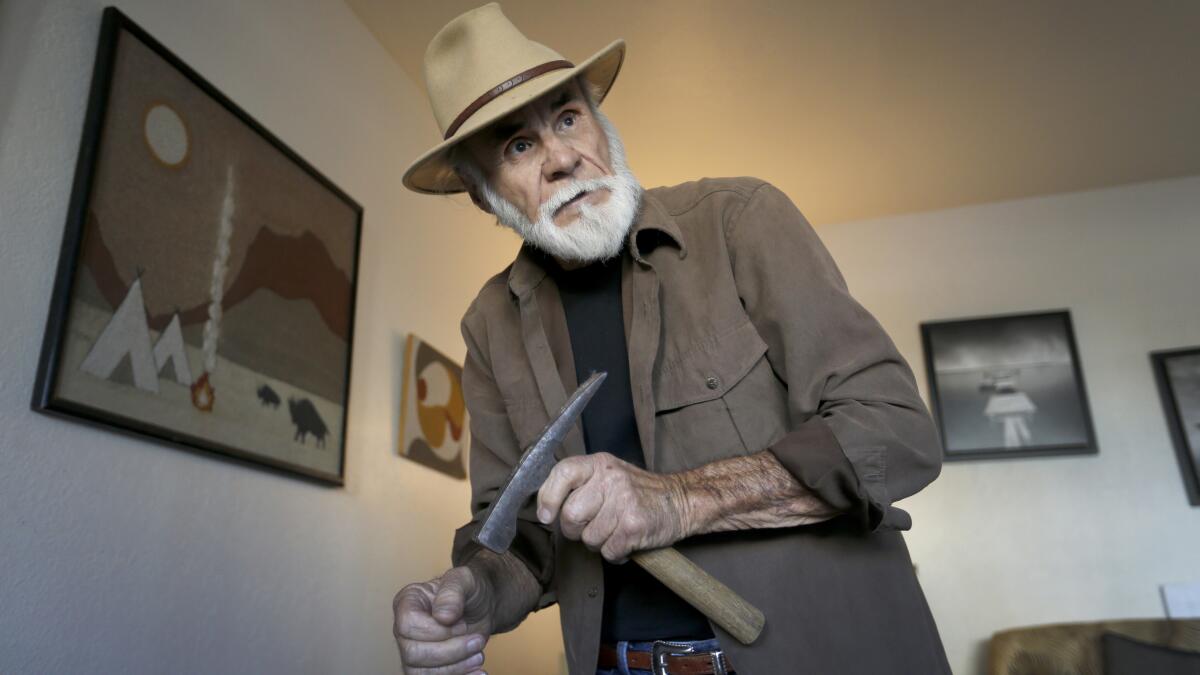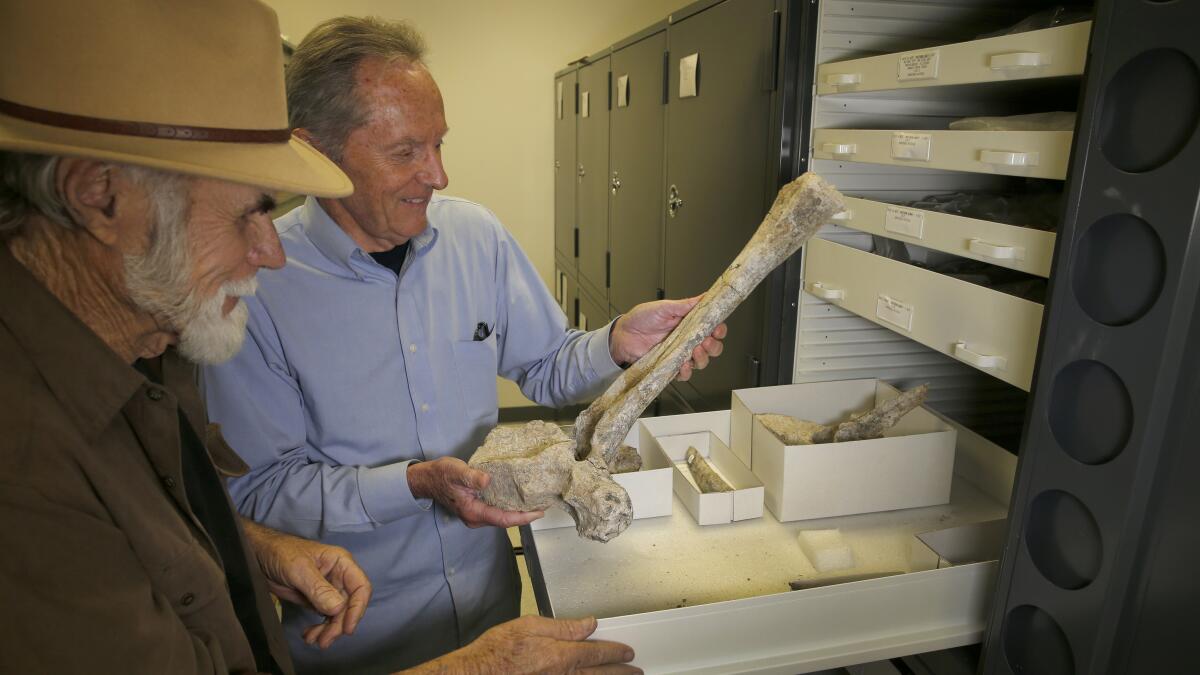Richard Cerutti, whose mastodon discovery shook up the archaeology world, dies

Richard Cerutti knew from an early age that he wanted to be an explorer of the past. He was not yet 10 when he joined his father at a construction site in La Jolla and began collecting fossilized clams and snails more than 30 million years old.
What began as a curiosity became an obsession that would one day lead to Cerutti’s name being attached to perhaps the most contentious discovery in North American archaeology when he found in a highway-widening project the tusk of a mastodon that would eventually bear his name.
Respected for his keen eye and a delicate touch with a rock pick, Cerutti died Sunday of non-Hodgkin’s lymphoma, according to his son Matthew. He was 78 and belonged to a generation of postwar scientists drawn to the coastal valleys of San Diego County for their wealth of fossil deposits.
Among colleagues at dig sites, he was known as Rooster for the red stripe on his hard hat, and he bore a striking resemblance to Burt Reynolds. His most prized possession was a butter knife lifted from a Black Angus restaurant.
“Richard had a deep personal connection with the earth and his place in the history of life,” said his friend Tom Deméré, curator of paleontology at the San Diego Natural History Museum. “He felt it was a privilege to be able to participate in this exploration and be part of the continuum of time – from the past to the present and into the future.”
While field work wasn’t glamorous and progress measured centimeter by centimeter through excavated sediments, Cerutti was driven by the answers that lay underfoot.
“We’re scientists,” he said, “and we want to know our own history…. Who were the first Americans? When did they get here? How did they get here?”
Growing up in San Diego County in the 1950s, he developed a love of nature exploring the undeveloped tracts of land east of National City. After a stretch in the Army in the early 1960s, he returned home to watch the hills of his childhood slowly disappear.
Earth-moving equipment cut into the uplifted coastal terraces, exposing ancient marine and terrestrial life. Without a degree or formal training, Cerutti explored construction sites and learned to listen to what each stone and specimen said about its history.
Making a living in the dirt was elusive, however. He took jobs hanging wallpaper, working as a carpenter, helping at an advertising agency, and when he felt cooped up, he headed outdoors.

An experienced knapper, Cerutti belonged to the arcane group of archaeologists who create stone tools with stones. By understanding how rocks fracture and break (“their DNA”), he could better distinguish man-made from natural objects.
“The New World – and San Diego – are blanketed with artifacts,” he said. “We just don’t recognize them.”
He once counted 45 buckets filled with chipped stones (“the lithic history of the people who lived here”) stacked in the living room of the home that he shared in Chula Vista with his wife.
In the early 1980s, he started working at the San Diego Natural History Museum, earning $8.50 an hour as a construction site monitor. He had just donated his prized specimens, doubling the museum’s collection of vertebrate fossils, and Deméré wasn’t about to let him go.
“He was the most generous person I have ever known,” said Deméré. “On more than one occasion, he would literally take the shirt off his back to lovingly wrap a fossil that he was transporting to the museum.”
Cerutti’s first paleontological site was a housing tract in Chula Vista, where an initial grading revealed “a gold mine of fossils.” After nearly a year, he and his team had unearthed 3,000 specimens, including a new species of whale and a partial skull of a distant relative to a manatee. Eager to share his enthusiasm for the planet’s ancient abundance, he oversaw the donation of a fossilized shell bed, weighing 37 tons, to the neighboring Clear View Elementary School.
A modest unassuming man, Cerutti often faced down foremen and construction crews who saw any delay as a financial loss, and according to Deméré, he often won them over with his willingness to share what he found.
His tenacity and commitment led to the discovery of new species that earned his name: a surf scoter (Melanitta ceruttii) and a porpoise with an extended lower jaw (Semirostrum ceruttii) from the Pliocene Age, and a carnivore (Ceruttia sandiegoensis) and primate (Brontomomys cerutti) from the Eocene Age.
But none of these finds was more meaningful than the mastodon he began to unearth on Nov. 16, 1992. After just a few hours brushing away soil from the fragment of tusk and discovering a nearby stone with a sharp edge, he knew the site was special.
“On the first day,” he said, “I got the feeling that something here was not geological. This is what came into my mind: Could this be an archaeological site?”
The proposition, linking man to the site, became controversial when preliminary dating of the specimens challenged the conventional assumption that man arrived in North America no earlier than 14,000 years ago.
For five months, Cerutti oversaw a team of paleontologists who patiently unearthed 50 square meters and collected more than 400 specimens. In El Nino rains, he rearranged waterproof tarps or operated a pump from the museum, and when the sun came out, he took out his butter knife to probe and pick at the grains of sandstone encasing each object.
The specimens now reside at the San Diego Natural History Museum.
In 2017, the prestigious scientific journal Nature published the findings, giving credence to the claim that the Cerutti Mastodon site, where early man had processed the bones of a mastodon, was between 121,000 and 140,000 years old.
Since then, attacks on the findings have increased. Although disappointed by the dismissive tone of critics in the archaeological community, Cerutti remained confident that the site would one day speak for itself.
“We’re not vacuum cleaner salesmen,” he said. “This isn’t something that needs to be pushed. We just want others to come out here to see what we have.”
Cerutti is survived by his wife, Aida Amar, four children and four grandchildren.
More to Read
Start your day right
Sign up for Essential California for the L.A. Times biggest news, features and recommendations in your inbox six days a week.
You may occasionally receive promotional content from the Los Angeles Times.








